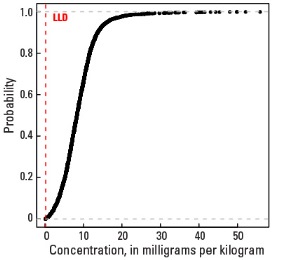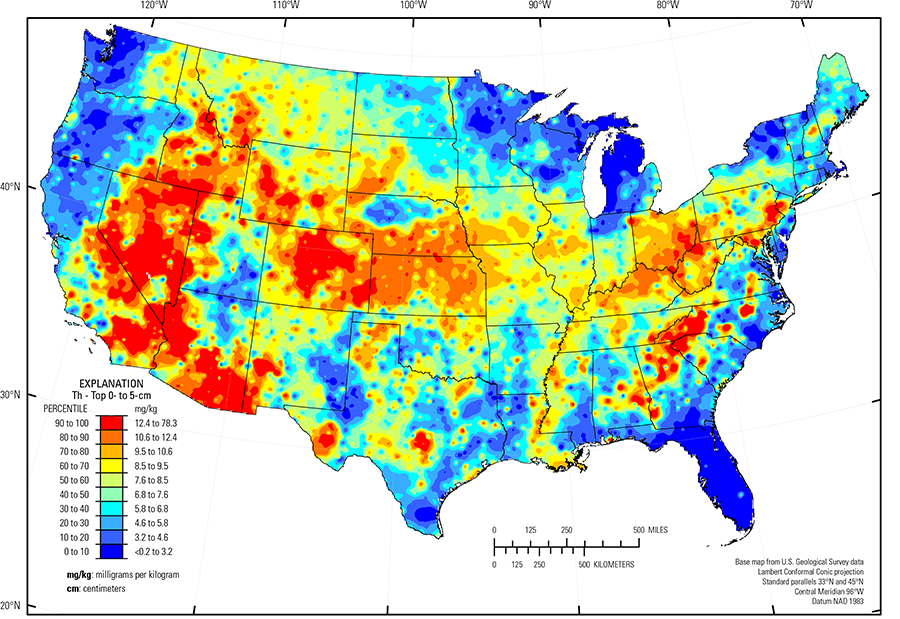
The purpose of these interpretive discussions is to provide a perspective on regional- and national-scale variations in element and mineral distributions in soils and their likely causes. The significant spatial variations shown by most elements and minerals can commonly be attributed to geologic sources in underlying parent materials, but other spatial variations seem clearly related to additional factors such as climate, the age of soils, transported source material, and anthropogenic influences. We attempt to distinguish the influence of these various factors on a regional and national scale. Numerous more local features might similarly be related to these same factors, but these features also have some probability of being an artifact of a random sampling of variable compositions, so that there is some probability of samples with similar compositions occurring in clusters of two or more adjacent sites by chance. Distinguishing such random occurrences from true variability is beyond the scope of the data from which these maps are constructed. Some caution, therefore, is advisable in interpreting the significance of these more local features unless some unique sources or processes can clearly be related to them.
Thorium (Th) is a weakly radioactive metal used primarily as an alloying agent to improve magnesium's (Mg) strength at high temperatures. Thorium can also be used as a source of nuclear power. It is considered to be nonessential to organisms and is toxic and a known carcinogen. More information about the toxicity of Th and its potential negative human health impacts can be found at the Agency for Toxic Substances and Disease Registry (ATSDR) website, or click to download a fact sheet about Th.
The distribution of Th in soils of the conterminous United States is controlled by the composition of underlying soil parent materials. The abundance of Th in the Earth's upper continental crust is estimated to be approximately 10.5 milligrams per kilogram (mg/kg) (Rudnick and Gao, 2003). Both Th and uranium (U) are radioactive elements that often occur together. Unlike U, which has several oxidation states, Th has only one oxidation state and thus is relatively immobile compared to U during weathering. In igneous rocks, Th is concentrated into late–stage accessory minerals such as monazite (a rare earth element–rich phosphate mineral that is the principal ore mineral for Th), allanite, apatite, and zircon. These accessory minerals typically occur in felsic rocks, such as granite, rhyolite, and pegmatite, and in alkalic igneous rocks, as well as metamorphic equivalents of these rock types. Granite has an average Th concentration of 15 mg/kg. Because many accessory minerals are resistant to weathering, they often are incorporated into derivative sedimentary rocks, such as shale or sandstone, and unconsolidated materials, such as alluvial, eolian, and glacial deposits. Shale has an average Th concentration of 12 mg/kg. Monazite is a common detrital mineral that, when released from its parent rock by weathering, can accumulate by density sorting in fluvial, lacustrine, or oceanic coastal shoreline settings. Thorium in soil can also bind to clay minerals and be sorbed onto iron (Fe) oxyhydroxides.
The distribution of mineral resource deposits with Th as a commodity (major or minor) in the United States, extracted from the U.S. Geological Survey (USGS) Mineral Resource Data System (MRDS) website, can be seen by hovering the mouse here. Statistics and information on the worldwide supply of, demand for, and flow of Th are available through the USGS National Minerals Information Center (NMIC) website.
In our data, the median concentration of Th is 8.3 mg/kg in the soil C horizon, 7.7 mg/kg in the soil A horizon, and 7.6 mg/kg in the top 0- to 5-cm layer (see the summary statistics [open in new window]). Nearly all samples have Th concentrations greater than the 0.2-mg/kg lower limit of determination (LLD). Regional map patterns indicating high or low Th concentrations are somewhat consistent among the three sample types, with some notable differences.
High Th concentrations occur in soil developed on felsic rocks present throughout the West, such as in the southern Sierra Nevada Mountains (USDA, 2006), the Southeastern Arizona Basin and Range (USDA, 2006), the Mojave Desert (USDA, 2006), and the Southern Rocky Mountains (USDA, 2006). In Texas, soil has developed on rhyolite, alkalic volcanic rocks, and derived alluvium in the Trans–Pecos volcanics (Schruben and others, 1997) and on Precambrian granitic rocks in the Llano Basin have relatively high Th concentrations.
Precambrian and Paleozoic granite and metamorphosed granite are the parent materials for many soils in the Piedmont (Fenneman and Johnson, 1946). Soils in the Piedmont are old and highly weathered, and high soil Th concentrations may be related to the presence of resistant accessory minerals, such as monazite, or retention of Th in secondary clays or Fe–hydroxides. High soil Th concentrations in the Carolina and Georgia Sand Hills (USDA, 2006), a transitional area (known as the 'fall line') between old crystalline rocks of the Piedmont and fluvial and marine sediments of the Atlantic Coastal Plain (Fenneman and Johnson, 1946) are likely related to concentrations of detrital minerals derived from the Piedmont. Occasional high soil Th concentrations in the Atlantic Coastal Plain (for example, in Georgia) may have a similar source.
Soil developed on phosphatic carbonate rocks and shale, as well as alluvium sourced from similar rocks, commonly has elevated Th concentrations. Examples of these areas include:
- Southwestern and central Wyoming where soils developed on Eocene–age marine sedimentary rocks;
- Much of the east–central part of the country, where soil developed on cyclic beds of sandstone, shale, and coal, for example the Western Allegheny Plateau and Central Allegheny Plateau (USDA, 2006), Cumberland Plateau (Fenneman and Johnson, 1946), and Southern Appalachian Ridges and Valleys (USDA, 2006); and
- Central Kentucky and Tennessee, where soil developed on phosphatic limestone and Devonian–age black shale.
In the Upper Midwest, melting of glacial ice following late Wisconsinan period advances (16,000 to 12,000 years ago) left the region north of the southern glacial limit (Soller and others, 2012) mantled with a blanket of mixed, immature sediments from which present–day soil developed. Individual ice lobes (Grimley, 2000) created distinct patterns in soil mineralogy and geochemistry because of varying provenance and ice transport paths. Thorium concentrations in soil throughout the glaciated region are relatively low, with only slightly higher concentrations in central and western Ohio where soil developed on glacial deposits that incorporated black shale from a thin unit that runs roughly north–south through the State. South of the southern glacial limit in eastern Nebraska, southern Iowa, and western Illinois, soil developed on loess has somewhat higher Th than soil north of the glacial limit. The higher concentrations of soil Th in the silt–sized sediment that makes up the vast loess sheets may be related to the presence of a small, but persistent, quantity of Th–rich accessory minerals, such as monazite, or to Th–bearing clays that may be a component of the loess.
Soil developed on sandy glacial deposits in northeastern Minnesota, north–central Wisconsin, and western Michigan all have very low Th concentrations. Other large areas (and their dominant soil parent materials) with low Th concentrations in soil include:
- Pacific Northwest and northern California (mafic and ultramafic rocks, including the Columbia River basalts (Swanson and Wright, 1981) and basalt and andesite of the Cascade Range);
- Adirondack highlands (Fenneman and Johnson, 1946), New York (anorthosite and gabbro);
- Nebraska Sand Hills (USDA, 2006) (quartz– and plagioclase–rich unconsolidated sand dunes and sand sheets);
- Southern High Plains (USDA, 2006) in eastern New Mexico and western Texas (quartz–rich eolian sands and alluvial sediments); and
- Most of the Gulf and Atlantic Coastal Plain (Fenneman and Johnson, 1946) (quartz–rich sedimentary rocks and unconsolidated sediments).
The Gulf and Atlantic Coastal Plain (Fenneman and Johnson, 1946) is bisected by the Southern Mississippi River Alluvium and the Southern Mississippi Valley Loess (USDA, 2006). Alluvial sediments have deposited in the Mississippi River valley as the river flooded in recent geologic time. When these sediments dried, winds picked up the fine material and deposited it in thick loess sheets, mainly along the east side of the river valley. The youngest loess sheets are about 10,000 years old. A pattern of higher Th in soil developed on these young sediments reflects long–range transport of material from areas containing elevated Th concentrations in the upper part of the Mississippi River drainage basin.
A limited number of sites have higher Th concentrations in the soil A horizon or the top 0- to 5-cm layer than in their paired soil C horizon. Thorium has been extracted from deposits in southern California and southern Arizona, so such surficial enrichments in these areas may be related to mining activities. In other parts of the country, for example in the Piedmont (Fenneman and Johnson, 1946), variable quantities of Th–rich resistant accessory minerals within a soil profile could result in higher Th concentrations in the soil A horizon and top 0- to 5-cm layer as compared to the soil C horizon.
Statistics - 0 TO 5 CM
| Number of samples | 4,841 |
| LLD | 0.2 mg/kg |
| Number below LLD | 6 |
| Minimum | <0.2 mg/kg |
| 5 percentile | 2.3 mg/kg |
| 25 percentile | 5.2 mg/kg |
| 50 percentile | 7.6 mg/kg |
| 75 percentile | 9.9 mg/kg |
| 95 percentile | 14.7 mg/kg |
| Maximum | 78.3 mg/kg |
| MAD | 3.56 mg/kg |
| Robust CV | 46.8% |
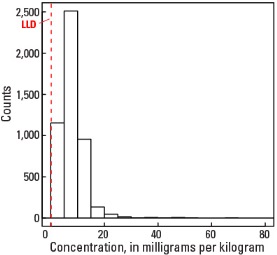
Histogram
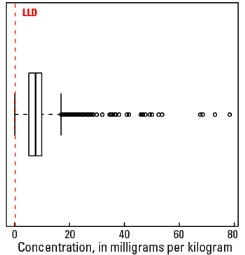
Boxplot
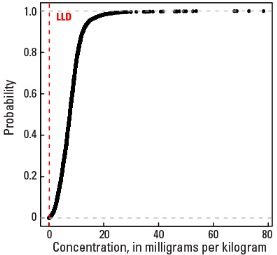
Empirical cumulative distribution function
Statistics - A Horizon
| Number of samples | 4,813 |
| LLD | 0.2 mg/kg |
| Number below LLD | 6 |
| Minimum | <0.2 mg/kg |
| 5 percentile | 2.2 mg/kg |
| 25 percentile | 5.3 mg/kg |
| 50 percentile | 7.7 mg/kg |
| 75 percentile | 10.0 mg/kg |
| 95 percentile | 14.4 mg/kg |
| Maximum | 84.1 mg/kg |
| MAD | 3.41 mg/kg |
| Robust CV | 44.3 % |

Histogram

Boxplot
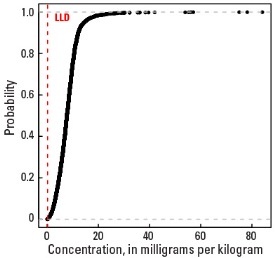
Empirical cumulative distribution function
Statistics - C Horizon
| Number of samples | 4,780 |
| LLD | 0.2 mg/kg |
| Number below LLD | 3 |
| Minimum | <0.2 mg/kg |
| 5 percentile | 2.4 mg/kg |
| 25 percentile | 5.8 mg/kg |
| 50 percentile | 8.3 mg/kg |
| 75 percentile | 11.0 mg/kg |
| 95 percentile | 16.1 mg/kg |
| Maximum | 55.9 mg/kg |
| MAD | 3.85 mg/kg |
| Robust CV | 46.4 % |
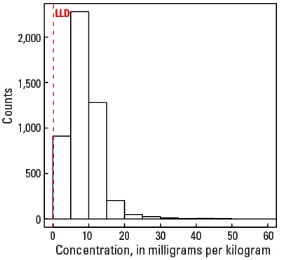
Histogram
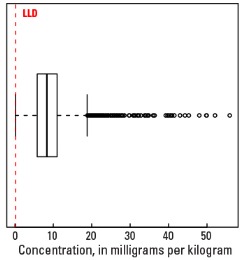
Boxplot
